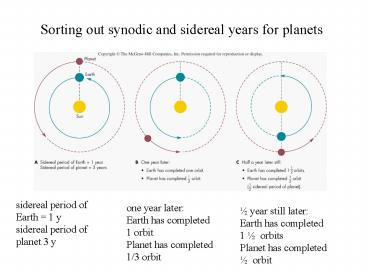Sorting out synodic and sidereal years for planets - PowerPoint PPT Presentation
1 / 13
Title:
Sorting out synodic and sidereal years for planets
Description:
Sorting out synodic and sidereal years for planets. sidereal period of Earth = 1 y ... The Analemma [at center of time zone (latitude 0 , 15 , 30 . ... – PowerPoint PPT presentation
Number of Views:64
Avg rating:3.0/5.0
Title: Sorting out synodic and sidereal years for planets
1
Sorting out synodic and sidereal years for planets
sidereal period of Earth 1 y sidereal period of
planet 3 y
one year later Earth has completed 1
orbit Planet has completed 1/3 orbit
½ year still later Earth has completed 1 ½
orbits Planet has completed ½ orbit
2
Whats happening at 9 mo 12 mo?
Start
- sidereal year (period) of earth
- PE 12 mo 1 y
- sidereal year (period) of planet
- P 36 mo 3 y
- they start at the top, when planet and sun
are in opposition - 9 months later planet and sun are in conjunction
- 12 months later planet and sun are 120º apart in
the sky and see caption at left
Start 12 mo
9 mo
9 mo
12 mo
3
After a total of S 18 mo 1.5 y planets
synodic year is complete, since planet and sun
are finally again in opposition
12 mo
- In general S synodic year P sidereal year
PE 1 y - Superior 1/P 1/PE 1/S
- Inferior 1/P 1/PE 1/S
12 mo
18 mo
Here 1/P 1 1/S 1/P 1 - 1/1.5 1/P 1 -
2/3 1/P 1/3 P 3 y
18 mo
4
The idea of greatest elongation inferior planets
only
5
Fig.04.11
Tycho Brahe looked but did not see parallax for
stars!!
- if Earth is NOT fixed at the center of the
celestial sphere - some stars are further away than others
- over one years time, nearby stars wiggle back
and forth against the backdrop of the distant
stars - he failed to see it
6
What is a parsec?
- with baseline of 2 AU, angle would be 2 for d
1 parsec - Brahes equipment was good enough to observe
parallax if stars were no more distant greater
than d 7000 AU - q D/d 2 AU/7000 AU .29 mrad
- .29 mrad(180º/p rad)(60 /º) 1 very
closely
- 7000 AU ? .1 ly
- 1 parsec 206,000 AU
- 1 parsec 3.26 ly 206,000 AU (parallax angle
2 ) - nearest star is 4 ly distant
1 AU
1
d 1 parsec
7
Johannes Keplers Laws of Planetary Orbits
- Kepler used Tycho Brahes incredibly good data
- There is no theory behind his laws they fit the
data - Planets orbit in ellipses, with sun at one focus
- -- planar, but not coplanar (or co-major-axial)
- -- circles are really too perfect non-eccentric
ellipses - Equal areas swept out in equal times
- -- slowest at aphelion, fastest at perihelion
- -- (period)2 (semi-major axis)3
- P2 a3 if P in years, a in AU
8
Drawing an ellipse Keplers 1st law
sun is at one focus, nothing is at the
other actually, at the focus is the
center-of-mass of the pair
9
Some ellipses, all with identical semi-major axis
abut different focal length f, (eccentricity e
f/a)
e 0 circle e 1 barely open orbit
f
a
10
Equal areas in equal times Keplers 2nd law
really a consequence of angular momentum
conservation
11
period P increases as semi-major axis a
increases, in a quantifiable way Keplers 3rd
law
if P is expressed in Earth years (y) and
semi-major axis a is expressed in astronomical
units (AU) then P2 a3 or P a3/2
- A AU P y v AU/y
- 1 6.3
- 2.9 4.4
- 5.2 3.6
- 8 3.1
- 11.2 2.8
- how is speed related to semi-major axis?
- v distance/time 2pa/P or P 2pa/v
- so 2pa/v a3/2 or v 2p/?a
12
The Analemma
- at center of time zone (latitude 0º, 15º, 30º .
. ) - asymmetric shape has to do with eccentricity of
Earths orbit (speed varies) - Locate a given day on the figure 8. June 21 is
at very top, and progress clockwise from there
Dec 21 is at very bottom - Horizontal time, in min, sun crosses your
meridian (noon) before (to L early) or after
(to R late) clock noon, on that day. Ranges
from 16 min early, to 14 min late - Vertical latitude for which sun strikes zenith
at noon, on that day (i.e. suns declination)
13
23.5
0º
-23.5
-16 min (early) 0 min 14 min (late)































